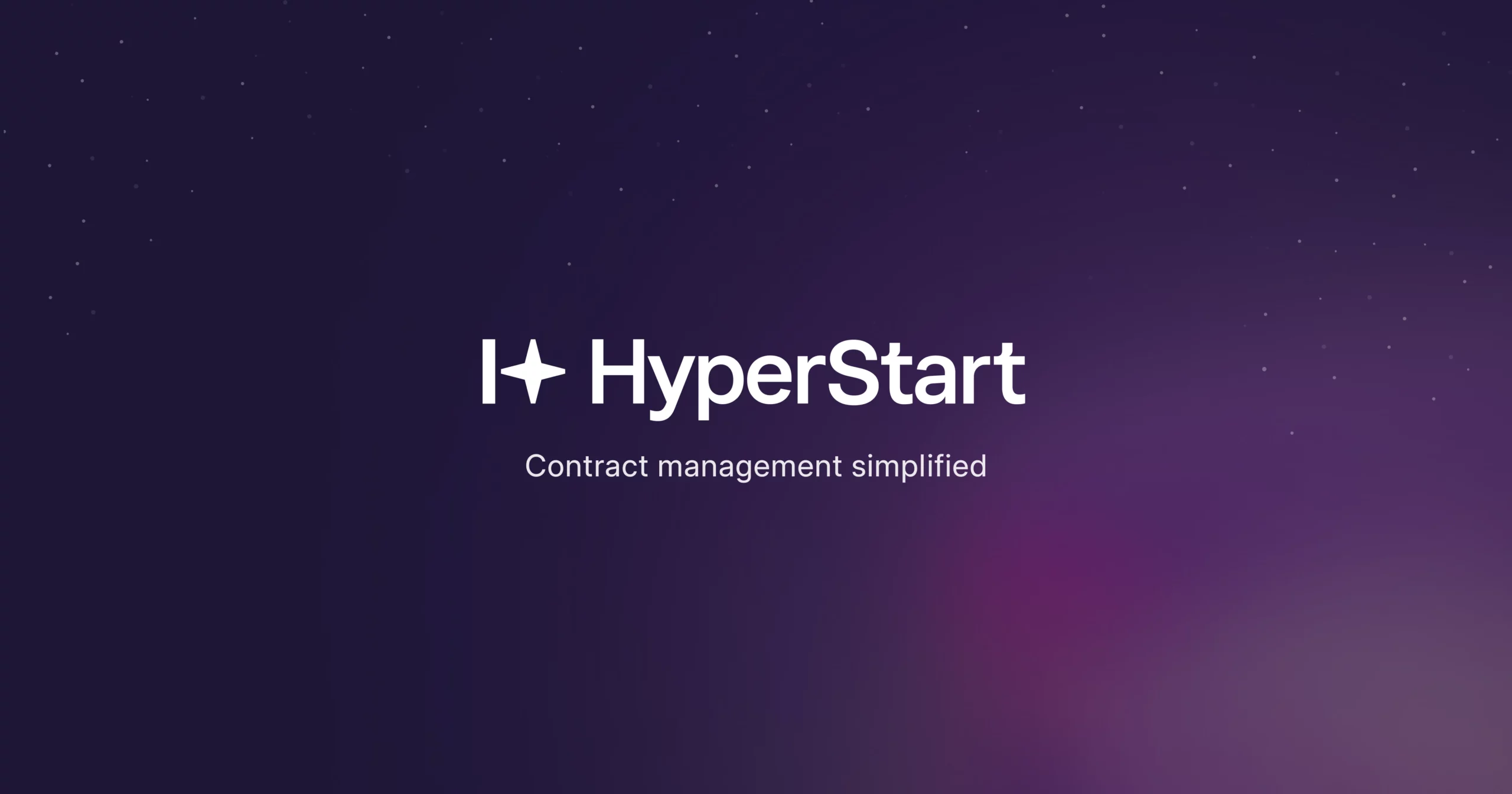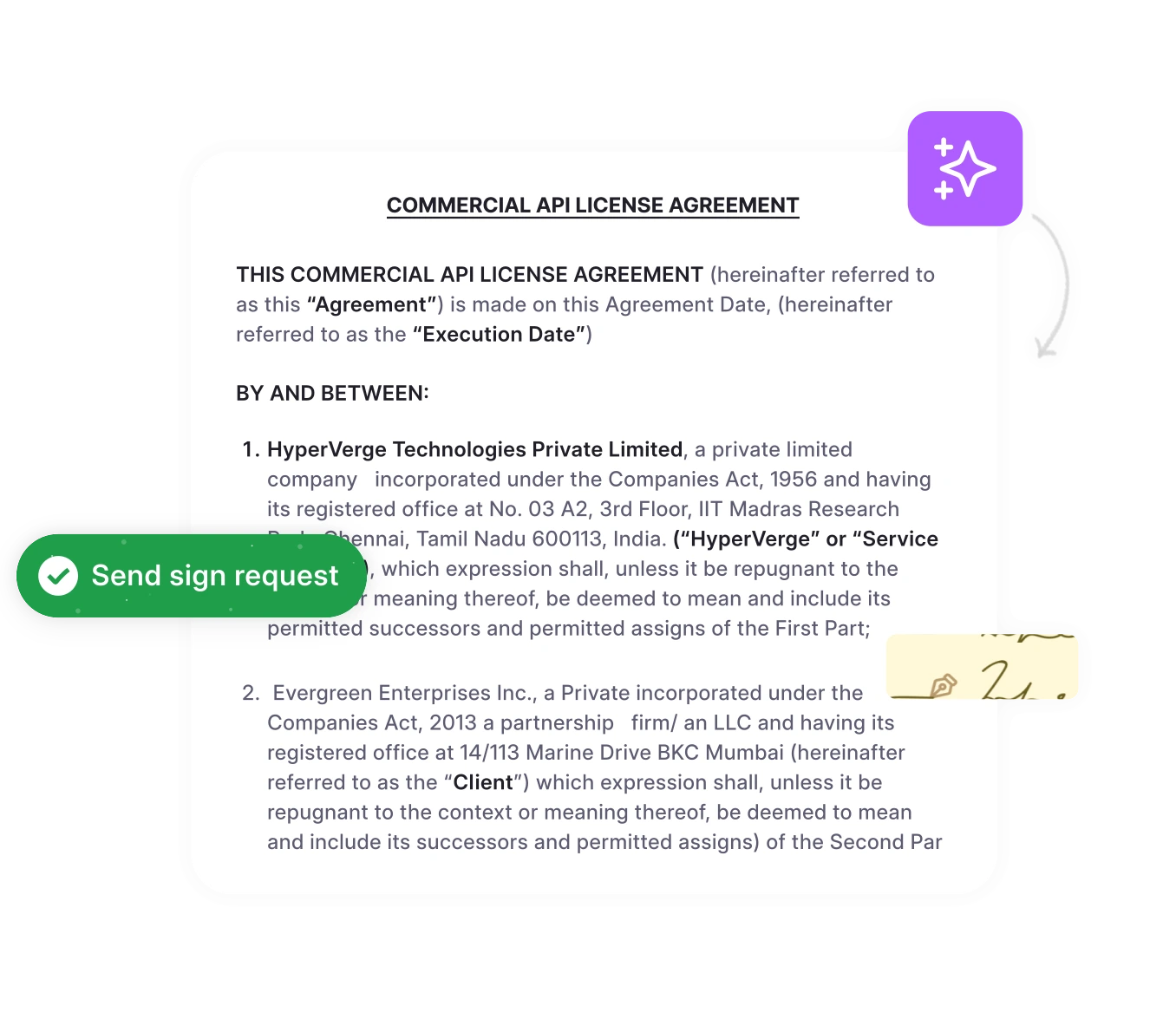Contracts are signed to record the promises and rights of each party. But if the terms need to change during the contract duration, there has to be room to make these changes quickly, safely, and legally. Modifications can happen because of price changes, timeline shifts, or changing business relationships. That’s where contract amendments come in.
Contract amendments allow businesses to make necessary updates clearly and legally without starting from scratch or facing compliance issues. Knowing how to handle these changes properly can prevent disputes, protect your interests, and save significant time.
This guide explains how contract amendments work. It covers when you need them and how to make sure they are legally enforceable. Let’s dive in clearly and confidently.
What is a contract amendment?
A contract amendment is an edit, correction, clarification, or deletion to an agreement that has already been executed. It leaves the original agreement intact. The signing parties get to clarify details or address a new need after entering the contract.
Contract variations include changes to the terms, an entire clause, one or more sections, or definitions. The amended contract is then signed by both parties to become legally enforceable. Common modifications include changes in:
- Price
- Duration
- Liability
- Scope
What is the purpose of a contract amendment?
The purpose of a contract amendment is to change, clarify, or add to specific terms. This keeps the original helpful agreement valid while the original contract’s unaffected terms remain enforceable.
Amendments cover things like significant details you missed or changes in circumstances like supply shortages or government guidelines.
Amendments must be formally done so all parties know and agree to modifications. Keeping the original contract’s core intact allows amendments without invalidating the entire agreement. They address the need to adapt to evolving needs or situations.
For example, after a major storm damaged a supplier’s warehouse, both companies agreed to amend their contract. They extended delivery timelines and added a clause allowing for alternative suppliers during emergencies. This way, they kept the partnership strong without canceling the whole agreement.
A contract amendment allows parties to formally update an existing contract without creating an entirely new agreement. It allows you to record changes or clarifications to specific terms. This keeps the rest of the original contract valid and enforceable.
Common reasons to amend a contract include:
- Addressing oversights or missing details that weren’t initially considered when drafting the agreement.
- Responding to unforeseen events, such as supply disruptions, labor shortages, or regulatory changes. During the COVID-19 pandemic, businesses changed contracts. They extended delivery times or adjusted prices. This was due to sudden changes in supply chains and workforce availability.
- Reflecting changes in business relationships, such as adding new responsibilities or removing outdated terms as partnerships evolve.
Contract amendments must always be formally documented and agreed upon by all involved parties. This ensures clarity, prevents misunderstandings, and maintains legal enforceability.
Common contract amendment types
Contract amendments typically involve changes in contract term length, prices or fees, parties’ liabilities, and periods for deliverables.
Contract amendments usually address specific modifications needed to adapt to changing circumstances. Common types include:
- Term amendments: Adjusting the length or duration of the contract (e.g., extending or shortening deadlines).
- Financial amendments: Changing payment terms, pricing, fees, or payment schedules to reflect new agreements or market conditions.
- Scope amendments: Revising the range of work, deliverables, or services included in the contract.
- Liability amendments: Modifying responsibilities, duties, or legal obligations of involved parties, often due to changes in risk profiles or compliance requirements.
- Delivery or timeline amendments: Altering agreed-upon timeframes for deliveries, milestones, or project completions, often due to logistical or operational shifts.
Other common amendments can revolve around renewal, termination, administrative, or price updates.
Other frequent amendments involve:
- Renewals: Extending the contract beyond the original expiration date.
- Termination clauses: Updating terms that allow one or both parties to end the contract.
- Administrative amendments: Correcting clerical errors, inaccuracies, or administrative details.
Automate amendments with ease
Stop manual tracking changes. Use HyperStart’s smart Word integration to edit, redline, and collaborate—all in one place.
Book a DemoUse cases for contract amendments
Contract amendments provide flexibility without requiring entirely new agreements. Here are the key scenarios where amendments prove valuable:
1. Contract extension in terms or delivery shipping times
If project timelines or shipping schedules change, amendments formally document the new deadlines or milestones.
Example: A software company first agreed to deliver a platform in six months. However, client-requested features now mean the project will take eight months. A contract amendment clearly captures this revised timeline.
2. Contract relationship change
As business relationships evolve, amendments capture these shifts in the formal agreement. This includes adding new rules, removing old terms, or changing the tasks and deliverables in the original contract.
Example: Two companies initially partnered for marketing services. Over time, their collaboration expands to include joint webinars and events. A contract amendment updates the scope to reflect these new activities.
3. Changes in the fee for a product or service
When financial aspects need updating, amendments document these changes. This includes adjustments to product prices, service fees, payment schedules, or payment methods.
Example: A manufacturer experiences increased raw material costs, requiring an adjustment in product pricing. The amended contract details these price changes and their effective dates.
4. Liabilities reallocations
Amendments are essential when the duties, risks, or responsibilities of either party need adjustment. This ensures all parties have clear documentation of who is responsible for what under the modified agreement.
Example: A supplier originally had full responsibility for delivery logistics but now contracts a third-party logistics provider. A contract amendment reallocates liability and clarifies each party’s obligations in this new arrangement.
Contract amendments are powerful tools that let you adapt agreements quickly, saving you time and administrative effort. Following proper amendment procedures ensures changes are legally enforceable, protecting all parties involved.
We’ll explore the enforceability requirements in detail in the next section.
How do contract amendments become enforceable?
Contract amendments only become enforceable when they are in writing and signed by all parties involved. For minor changes like spellings, names, and dates, handwritten changes on the agreement can be signed with initials. For major changes, you can follow these steps:
Step 1: Clearly draft the amendment terms
A new document needs to define the sections, clauses, portions, language, or definitions to be updated. After this, the current date, as well as the date and title of the original document, is added.
This can look like:
8 April 2025, Amendment to MSA dated 1 April 2025
Step 2: Attach the amendment to the original contract
Attach the clearly drafted amendment document (with redlines and tracked changes if applicable) to the original contract. All other conditions and terms not changed by the amendment will remain in full force.
Step 3: Send for counterparty review and negotiation
Before execution, you can invite the counterparty to collaborate on the document and propose any further changes.
Step 4: Review with legal counsel (internal or external)
Always review substantial amendments with your legal team to ensure compliance, accuracy, and enforceability. Your counsel will verify legality, protect your interests, and address any ambiguities before final execution.
Step 5: Secure signatures to bind all parties
After final approval, all involved parties must formally sign and date the amendment. Depending on jurisdiction or complexity, consider notarizing the document or including witnesses.
Finally, distribute signed copies to everyone involved and store them securely alongside the original agreement.
By diligently following these steps, you ensure the amendments are legally binding, enforceable, and clearly documented—reducing risk and strengthening your contractual relationships.
Next, we’ll also look at another way contracts can be updated and how it differs from an amendment.
Differences between a contract amendment and a contract addendum
Let us now break down the key distinctions between the two contract modification types.
Contract addendum: A contract addendum is something you add to a contract. It is usually present when the original contract is signed. Think of it as an attachment that introduces supplementary information like extra terms and conditions. It is governed by the existing contract terms and does not need separate signatures. Common addendum use cases occur in travel policies, insurance requirements, and financing terms.
Contract amendment: An amendment can add, remove, or clarify terms in a contract after it has been signed. It is typically introduced after the contract is already signed, while the rest of the contract remains effective. It requires formal signatures from both parties. Changes in contract pricing, extension of contract dates, increased total contract value, and updates in processes are common contract amendment use cases.
When modifying contracts, it’s crucial to distinguish between amendments and addendums, as they serve different purposes in contract management. Knowing when you need contract amendments is essential for maintaining both legal compliance and effective business relationships.
Next, let’s clear up a few common questions, starting with what a contract amendment is and what it isn’t. This will help determine when contract amendments are appropriate and permissible in the next section.
Common questions around contract amendments
The timing of modifications significantly impacts whether they constitute true amendments. Some commonly asked questions about contract amendments:
1. Can a contract be amended pre-execution?
No. Changes made to a contract before it is signed aren’t considered amendments. These changes are part of the contract negotiation and redlining process. This is the first stage where both sides discuss terms. They work together until they reach an agreement.
2. Can a contract be amended post-execution?
Yes. Once a contract has been signed, it becomes legally binding. If circumstances change afterward, amendments must be formally documented, clearly stating the revised terms. All involved parties must explicitly agree to these changes by signing and dating the amendment. This process is crucial for clarity and to prevent future disputes.
A construction company can change the completion date of a building project. For example, if they promised to finish it in 12 months but face delays, they can adjust the timeline. This amendment will show the new timeline.
3. Can a contract be amended by one party alone?
No. Contract amendments cannot be made unilaterally. For an amendment to be enforceable, all parties involved must explicitly agree to the proposed changes. One-sided modifications are invalid and not legally enforceable.
If you want to change the terms, clearly suggest these changes to the other party. Give reasons for the changes and get their formal agreement.
By adhering to these guidelines, organizations ensure that contract modifications remain valid, legally enforceable, and compliant throughout the contract lifecycle.
One platform for every contract amendment
Create, edit, approve, sign, and store amendments—all inside HyperStart CLM. Manage the full contract lifecycle effortlessly.
Book a DemoCommon mistakes to avoid when amending contracts
Even small changes to a contract can cause big issues if not handled carefully. Avoid these common missteps to keep your contracts clear, enforceable, and risk-free.
- Not putting it in writing: Verbal changes don’t hold up well. Always write it down and get it signed.
- Skipping signatures: If all parties don’t sign, it’s not official. Everyone has to agree.
- Amending after it’s expired: If the contract has already ended, it’s too late to amend. Start fresh with a new one.
- One-sided changes: One party can’t change things alone. Both must agree and sign off against any updates.
Contract changes should be handled carefully and follow a formal process. This helps save time, protect business relationships, and lower legal risks.
Contract Amendment Best Practices Checklist
Amendments are easier when you follow a clear process. Here’s a checklist to help you manage each step with confidence and control.
Before You Start
☐ Check if the contract is still active. If it’s expired, create a new one.
☐ Confirm that both parties agree to the change and get the amendment reviewed by legal.
Drafting
☐ Use Word integration to draft or upload amendments.
☐ Link amendments directly to the original contract in your repository.
☐ Enable version control to track changes and avoid confusion.
Internal Review and Approval
☐ Use tracked changes to highlight every edit.
☐ Add internal comments to keep conversations clear and focused.
☐ Route amendments to the right stakeholders with @mentions.
☐ Log every action automatically for full visibility.
External Negotiation
☐ Share redlined versions for transparent negotiations.
☐ Compare internal and external versions side by side.
☐ Document all feedback and changes during the review.
Final Sign-Off
☐ Use eSignature or connect with tools like DocuSign for safe and legally binding signatures.
☐ Monitor progress and get notified once everyone signs.
Post Execution
☐ Store the amendment in the same place as the original contract.
☐ Make it searchable and apply access controls as needed.
☐ Use AI to extract new obligations and update dashboards.
☐ Set alerts for deadlines or actions based on the amendment.
Use this checklist to keep track of contract changes. It helps you stay informed and make sure every amendment is clear, legal, and enforceable.
How contract amendments are managed on HyperStart CLM management software
Contract amendments represent critical modifications to existing agreements, requiring careful handling throughout their lifecycle. HyperStart AI-Powered Contract Management Software helps manage contract changes from start to finish. It ensures that organizations keep control and see all changes to contracts.
Pre-signature amendment management
HyperStart’s Word integration offers multiple pathways to create amendments with precision and efficiency.
- You can draft amendments directly within the platform using familiar Microsoft Word functionality.
- Or upload pre-drafted amendments and associate them with existing contracts.
Both methods are powered by version control to prevent confusion or misplacement.
Collaborative contract management workflows
Before sharing amendments with counterparties, internal stakeholders can collaborate effectively through:
- Tracked changes for complete visibility into modifications at the workflow or clause level.
- Comprehensive audit log that documents every interaction with the document on the platform, on email, or on Slack.
- Internal commenting that keeps conversations transparent and contextual.
- Version control that preserves the amendment’s evolution through multiple iterations.
- Approval routing that ensures that the right stakeholders review at the right time. And @mention capabilities that loop in the relevant stakeholders at specific times.
Counterparty negotiation and approval
HyperStart facilitates efficient negotiation with external parties through:
- Redlining capabilities, comment and response tracking that displays proposed changes and document all negotiation points.
- Structured negotiation workflows that maintain process integrity.
- Document comparison of your internally proposed amendment and the counterparty version to highlight evolution.
Once amendments are finalized, execution via HyperStart ensures security, compliance, and simplicity:
- Native eSignature functionality built directly into the platform
- Integration with popular third-party eSignature solutions
- Automated routing to ensure proper signature sequence
- Status tracking to monitor signature progress
- Automated notifications upon completion
Post-signature amendment management
Intelligent repository management
After execution, HyperStart automatically:
- Files the amendment in the central contract repository
- Links the amendment to its parent contract, eliminating the risk of separation from original contracts
- Makes both the amendment and original contract searchable through advanced filtering
- Applies appropriate access controls based on organizational policies while ensuring stakeholder access to the current version
- Maintain the complete document history for audit purposes
AI-powered obligation tracking
HyperStart’s artificial intelligence capabilities transform static documents into actionable information with proactive monitoring. It prevents compliance issues that could arise from overlooked modifications. The platform:
- Automatically extracts key dates, obligations, and liabilities from amendment text
- Updates dashboards to reflect the modified agreement
- Enables configurable alerts for upcoming deadlines and provides stakeholder notifications based on role and responsibility
HyperStart addresses different aspects of the contract lifecycle with a modern, intuitive interface that gets your users. You reduce risk and administrative burden, improve visibility, compliance, and collaboration, and stay on top of obligations with advanced reporting and analytics. Create, approve, sign, and track all contract amendments without manual effort. Get a walkthrough today. Book a demo.












